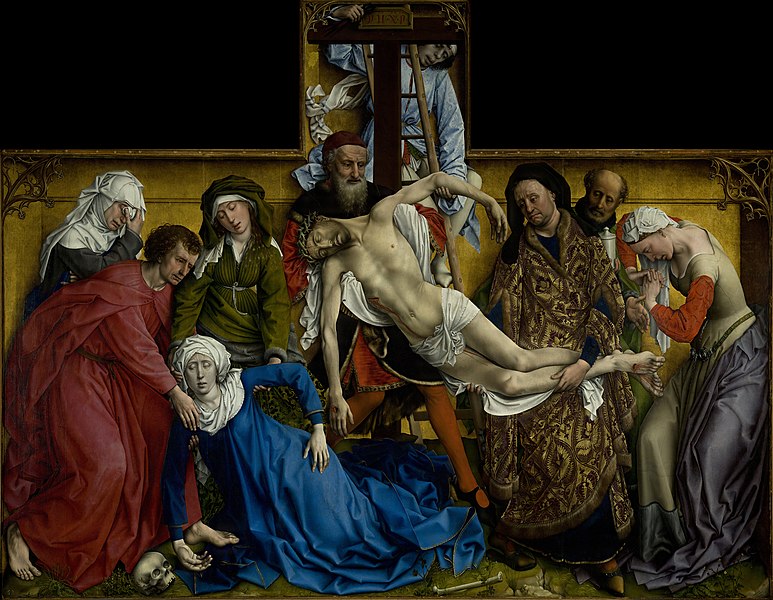History tells us that tearing down statues is divisive and traumatic, a sort of village-by-village civil war.
 |
| The Ghent Altarpiece survived destruction because of the courageous actions of a few. |
Yesterday, red paint was splashed on the statue of Theodore Roosevelt on the steps of the American Museum of Natural History in New York City. This comes on the heels of Mayor Bill de Blasio’s appointment of a commission to review monuments, and calls by activists to remove this particular ‘racist’ statue. These follow a nationwide wave of monument destruction.
There is a word for this in English: iconoclasm. This specifically means the destruction of icons, images or monuments for religious or political reasons. It happens during political revolution and periods of religious fervor. We decry it when it is done by the Taliban; are we willing to examine our own behavior with the same critical lens?
 |
|
Remains of Reformation iconoclasm, Clocher Saint-Barthélémy, La Rochelle, France, courtesy World Imaging.
|
The Protestant Reformation unleashed a wave of iconoclasm across Northern Europe and England in the 16th century. The result was the destruction of significant cultural works, including many more Northern European Renaissance paintings than were ever saved.
These attacks went by different names: the Iconoclastic Fury, the Beeldenstorm (Dutch), Bildersturm (German) or, in England, the Dissolution of the Monasteries. In France, the violence was part of the Huguenot Wars. Whatever it was called, it was part of the anti-Catholic revolution we now call the Reformation. The violence was often official.
No thought was given to the artistic heritage of the destroyed works. In England, 90% of religious art was destroyed in the years following the Reformation. The percentages are probably similar in Germany and the Low Countries. The purge extended equally to music and literature.
|
Altar piece in St. Martin’s Cathedral, Utrecht, attacked in the Beeldenstorm in 1566. This was hidden behind a false wall and rediscovered in 1919. Courtesy Pepijntje.
|
Occasionally, great works were saved by individuals or families. The most well-known is the van Eycks‘ Ghent Altarpiece, an outstanding example of Early Netherlandish painting. It was already famous in August of 1556, when the Beeldenstorm hit Ghent. An attack on the Cathedral on August 19 was deterred by guards. On August 21, the iconoclasts used a tree trunk as a battering ram to break through the doors. By then the panels and the guards had been hidden on the narrow spiral staircase within the tower. The panels were then hidden in the town hall. The original, elaborate frame was destroyed.
In Britain, Henry VIII disbanded monasteries, priories, convents and friaries in his dominions. He took their income and sold, appropriated or destroyed their assets. Much of this served to fund his military campaigns in the 1540s.
Shrines to saints were destroyed, libraries were burned, and many precious relics were lost. The more fortunate of cathedrals and abbeys saw their jeweled reliquaries stripped, precious metals and ornaments looted, and their painted walls covered with whitewash. The less fortunate houses were leveled and their leaders strung up. Among these were Glastonbury Abbey, legendary for the tomb of King Arthur.
 |
|
Medieval altarpiece fragments destroyed during the English Dissolution, mid-16th century, courtesy PHGCOM, photographed at the Museum of London.
|
Henry’s son, Edward, was depicted during his life and afterwards as a new Josiah, destroying the idols of Baal. Although he only reigned six years, they had a lasting impact on the English Reformation. His counter-reforming sister is now remembered as Bloody Mary, but she was just another 16th century leader who used murder to advance her religious agenda.
As I watch our country going through its first real experience with iconoclasm, I wonder about a favorite bronze relief in Boston. An historical illiterate might see the Robert Gould Shaw Memorial as racist. After all, it’s a white officer on horseback, surrounded by black men. But it’s not, and it’s also a masterpiece by Augustus Saint-Gaudens.
As the 16th century saw, violence against objects usually goes hand in hand with violence against people. The destruction was divisive and traumatic to communities, a sort of civil war on a town-by-town basis. It’s nothing you’d wish on the people you love.



